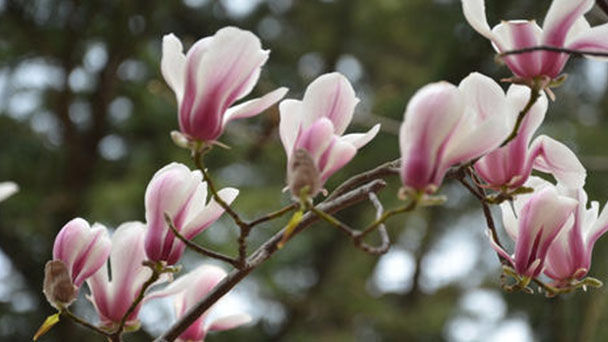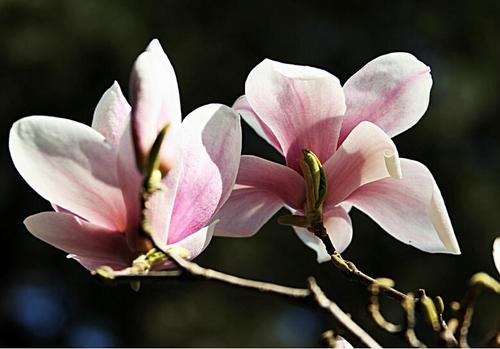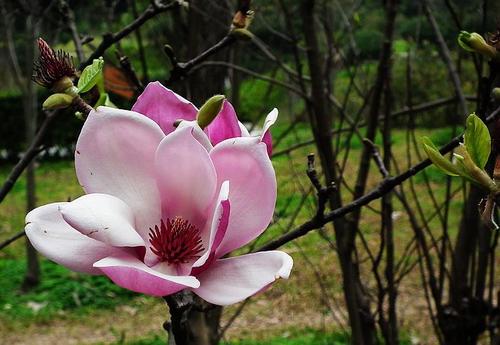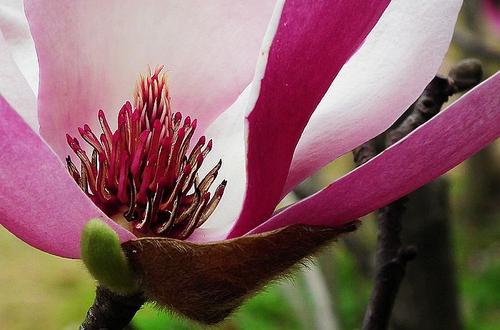Saucer Magnolia Tree (Magnolia Soulangeana): Info, Care & Growing Guide
Written by Maggie
Oct 30 2021

Saucer Magnolia, scientific name Magnolia soulangeana, is a small deciduous tree that can reach up to 15 meters in height. Leaves are obovate or broadly obovate, apex broadly rounded, under mask pubescent. The fragrant, early-spring blossoms are white-shaded with light to deep pink or purplish-pink, which makes it a very popular flowering tree.
Saucer Magnolia Picture

Saucer Magnolia Info
| Botanical Name | Magnolia x soulangiana |
| Common Names | Saucer magnolia, Chinese magnolia, Saucer magnolia tree |
| Plant Type | Flowering tree |
| Bloom Time | Spring |
| Flower Color | Pinkish-white |
| Light | Full sun to part shade |
| Hardiness Zone | 4 to 9 |
| Native Range | Parent species are from China |
| Mature size | 20 to 25 feet tall and wide |
| Growth Rate | Medium to fast growing |
Features of Saucer Magnolia
Saucer Magnolia Branch
Saucer magnolia is a small tree, 6 to 10 meters tall, with small branches that are hairless.
Saucer Magnolia Leaf
Saucer Magnolia Leaves are Parish, Obovate, 6-15 cm long, 4-7.5 cm wide, apex short and acute, tapering into cuneate below 2/3, midveins often remain hairy in the upper base, more or less pilose below, lateral veins 7-9 on each side, veins convex on both sides when dry, petiole 1-1.5 cm long, pilose, stipule markings about 1/3 of the length of petiole.
Saucer Magnolia Flowers
Saucer Magnolia: Ovate buds, open flowers in the first leaves, pale red to dark red, tepals 6-9, 3 tepals on outer rings, usually shorter and about 2/3 the length of inner rings; Stamens are 1-1.2 cm long, anthers ca.5 mm, laterally dehiscent, septa protruding into a mucronate, pistil glabrous, cylindrical, ca. 1.5 cm long.
Saucer Magnolia Fruit
Saucer Magnolia's fruit is about 8cm long and 3cm in diameter; Follicles are ellipsoid or obovoid, 1-1.5 cm long, black when ripe, with white lenticels; Seeds are dark brown, broadly obovate or obovate, laterally oblate.
Hybrid Saucer Magnolia
Saucer Magnolia tree is a hybrid of Magnolia magnolia and Magnolia magnolia. The perianth segments of this species vary in size and shape, ranging from purple to sometimes nearly white. There are about 20 species in horticultural cultivation.
Saucer Magnolia Native Habits
Saucer Magnolia tree loves the sun and warm, humid climates. Saucer magnolia is sensitive to temperature and can bloom four to five months from north to south. Even within the same region, the time of flowering can vary wildly from year to year. Saucer magnolia has a certain resistance to low temperature and can overwinter safely under -21℃ condition.
How to Grow and Care for Saucer Magnolia
Saucer Magnolia Light Requirements
Saucer Magnolia tree has a demand for light in the growth, and is suitable for keeping in a place with good light. Sufficient sunlight should be kept in the growth period to avoid poor growth due to lack of light. If it is potted maintenance, it can be placed on the balcony or outdoors.
Saucer Magnolia Soil Care
Saucer magnolia bushes are pleasant in moist, acidic, organically prosperous and well-drained loamy soil, although they will tolerate clay soils.
Saucer Magnolia Watering
During the first 12 months of planting, water the tree deeply and frequently. Afterward, saucer magnolias want irrigation solely when the climate is dry. Once established, these timber have a rather appropriate tolerance for drought.
Saucer Magnolia Temperature & Humidity Care
Cool, wet climate tends to purpose fungal leaf spots and cankers on Saucer magnolia. If possible, keep away from splashing soil from the floor onto the plants, and provide them top air circulation.
Saucer Magnolia Fertilizer
Saucer magnolia is now not heavy feeders, however they advantage from mixing fertilizer into the soil when planting, then gently feeding them every spring with a balanced slow-release fertilizer. For annual spring feeding, do not combine the fertilizer into the soil, however as an alternative unfold it over the floor round the plant, then water it in.
Pruning Saucer Magnolia
Saucer magnolia bushes frequently produce more than one stem. To structure it into a tree form, prune away all however one stem to serve as a dominant trunk. Such drastic pruning must be completed whilst the tree is nonetheless young. You may additionally structure the crown in later years by using pruning gently after the flowering period. Remove any useless or diseased branches as you see them, ideally in dry climates when fungi are much less likely to infect pruning wounds.

Saucer Magnolia Propagation
Saucer Magnolia is available for sowing, grafting, cutting, laminating and tissue culture propagation.
Saucer Magnolia Propagation from Seed
Saucer magnolia tends to be limp after flowering, while the few solid fruits ripen in September and October. Pour next mature fruit, dry in indoor shade for 1 day to 2 days, take off the seeds of the red skin, a little pile retting after using fine sand or put in water rub the red skin dry in the shade, die in the sun, can not lose water, appropriate namely pick namely sow or mix wet sand storage to the next year February to March sowing, germination rate 70% to 80%. Saucer Magnolia is a hybrid with unstable offspring that cannot maintain all the habits of a good variety. Therefore, it is rarely used in the breeding of good varieties but is often used in the breeding of new varieties.
Saucer Magnolia Propagation from Cutting
Saucer Magnolia is cut from May to July when growth is at its peak. The choice sapling is born in that year branch makes cutout, the upper part stays a few leaves, immerse branch lower part 50 mg/l indole acetic acid, root powder or nafthene acetic acid after 6 hours, insert wet sand or vermiculite bed inside, proper shade, and often spray protect moisture, the survival rate can reach 70% or so.
Saucer Magnolia Propagation from Grafting
Usually, Saucer magnolia parents such as purple magnolia or magnolia, this species or yellow orchid, white orchid and other genus plants are used as rootstocks, which can be split grafted, bud grafted, cut grafted, belly grafted and other ways, but the survival rate of split grafted and bud grafted is higher.
Saucer Magnolia Propagation from Layering
Choose well-growing plants, take 1 to 2-year-old branches of 0.5 to 1.0 cm thick for layering, if there are branches, can be pressed on the branches. Layering time in February to March is better after the pressure can take root in the same year. Saucer magnolia can flower in 2 to 3 years after transplanting.
Saucer Magnolia Propagation from Tissue Culture
Saucer Magnolia can maintain its excellent characteristics in tissue culture. The terminal buds and lateral buds are generally used as explants. The medium for primary and secondary culture is MS+3.0mg/L6-BA+0.2mg/L LIBA, and the medium for root induction is 1/2MS+0.5mg/LNAA.
Saucer Magnolia Disease & Pest Care
Saucer Magnolia should be protected against underground pests such as blight, root rot and grubs. Saucer Magnolia should be protected against red spiders in the middle of summer.
In addition to the prevention and control of chlorosis and root rot in the management process, but also prevention and control of anthrax. If the disease is found, the diseased plant and leaf should be removed in time, and at the same time, the leaves should be sprayed with 50% carbendazim solution 500~800 times, or 70% tobutazine solution 800~1000 times for prevention and control.
Aphids
If aphid is found to be harmful to buds and buds, it can be killed by quick killing or by 500 times of washing powder, and then sprayed with clean water to wash the branches and leaves.
Insect pest shell
The pest of scale shell insects can be sprayed with 0.3%~0.4% vinegar.
Magnolia Tree Varieties
Magnolia Amoena Cheng
Magnolia Campbellii Hook. F. et Thoms.
Magnolia dawsoniana Rehd. Et Wils.
Magnolia Denudata Desr.
Magnolia Elliptigemmata C. L. Guo et L. L. Huang
Magnolia Multiflora M. C. Wang et C. L. Min
Magnolia sargentiana Rehd. Et Wils.
Wudang Mulan Magnolia Sprengeri Pampan.
Magnolia Zenii Cheng
Magnolia, for the magnolia family magnolia plants. Also known as magnolia, jade tang spring, winter jasmine, hope spring flower, should spring flower, wood tree.
Two Qiao Magnolia outside with purple, calyx length is half the petal.
Magnolia is a deciduous shrub, with small green sepals, 6 petals, purple outside, white inside, no fragrance.
Magnolia magnolia leaves evergreen, thick leather, brown hair under the leaves.
Saucer Magnolia Uses
Saucer magnolia flower contains aromatic oil, which can be extracted to prepare essence or extract; Perianth segments ate or used for fumigating tea; The seeds are pressed for oil for industrial use. Early spring white flowers full of trees, gorgeous fragrance, for the famous Chinese and foreign garden ornamental species.

Latest Updated
- Benefits of Bugleweed - 7 Science-backed Health Benefits
- Bugleweed Dangers & Side Effects - Is It Poisonous?
- How to Plant Evergreen Trees - What You Should Know
- When to Plant Evergreens - Grow Guide for Evergreen Trees
- 12 Wonderful Evergreen Shrubs for Your Garden
- 12 Popular Evergreen Plants with Pictures for Beginners
- When And How To Prune A Lilac Bush Like a Pro
- How to Grow & Care for Lilac Vine (Hardenbergia Violacea)
- Japanese Lilac Tree (Syringa Reticulata) Care & Propagation Guide
- Shumard Oak Pros and Cons - What to Know
Popular Articles
- Winter maintenance of Antirrhinum Majus
- How to Grow Terminalia Mantaly Tree
- How to Grow and Care for Crossostephium Chinense
- How to grow Antirrhinum Majus in spring
- Peristeria Elata (Dove Orchid) Profile: Info & Care Guide
- Underwatered Snake Plant (Sansevieria Trifasciata) - Signs And How To Fix
- How to Care for Brazilian Jasmine Plant (Mandevilla Sanderi)
- How to Grow & Care for Graptopetalum Purple Delight in Summer
- Rosa Chinensis (China Rose): Plant Growing & Care Tips
- How to Care for Baby Sun Rose (Aptenia Cordifolia)